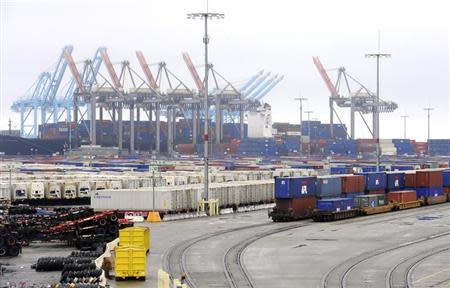Wider U.S. trade deficit to weigh on first-quarter GDP
By Lucia Mutikani WASHINGTON (Reuters) - The U.S. trade deficit unexpectedly widened in February as exports hit a five-month low, suggesting first-quarter growth could be much weaker than initially anticipated. Despite the trade setback, the economy remains on track to regain momentum as the year progresses. Other data on Thursday showed activity in the services sector accelerating in March after being hampered by unusually cold weather. "At this point, it appears that growth will struggle to top one percent" in the first quarter, said Peter D'Antonio, an economist at Citigroup in New York. The Commerce Department said the deficit on the trade balance increased 7.7 percent to $42.3 billion, the largest since September last year. The inflation-adjusted gap widened to $50.1 billion from $48.5 billion in January. Economists, who had expected the deficit to narrow to $38.5 billion, said trade could slice off as much as half a percentage point from first-quarter gross domestic product. It added about a percentage point to fourth quarter GDP. First-quarter growth estimates, already on the low side were marked down. RBS slashed its first-quarter GDP estimate to an annualized rate of 0.6 percent from 1.2 percent. Barclays and Morgan Stanley cut their estimates by three-tenths to a 1.9 percent and 1.2 percent rate, respectively. The economy grew at a 2.6 percent pace in the final three months of 2013. The economy has faced a series of headwinds, ranging from the unseasonably cold temperatures to businesses placing fewer orders with manufacturers after rapidly stocking up their warehouses in the second half of last year. Growth has also been clipped by the end of long-term unemployment benefits and cuts to food stamps. U.S. Treasury debt prices were trading higher on the mixed economic reports, while stocks on Wall Street were marginally lower. The dollar rose against the euro after the European Central Bank kept interest rates on hold and pledged to use unconventional measures if needed to fight low inflation. WEAK EXPORTS In February, exports fell 1.1 percent to $190.4 billion, the lowest level since September. Exports dropped in nearly all categories, with the largest decline in industrial supplies and materials. While exports to China tumbled 4.6 percent, a 19.5 percent plunge in imports narrowed the politically sensitive U.S. trade deficit with the world's second-largest economy to its smallest level since March 2013. Some of the drop in imports was likely due to the Chinese New Year holiday. Though overall imports rose 0.4 percent, petroleum imports were the lowest in a year. Declining petroleum imports as a domestic energy production boom reduces the nation's dependency on foreign oil helped to shrink the trade deficit last year. The current account deficit hit a 14-year low in the fourth quarter of 2013. Economists were optimistic of a pick-up in exports, citing a strong rise in the export orders component in the Institute for Supply Management's March manufacturing survey. "Some of the February weakness probably reflects weather-related transport delays," said Ted Wieseman, an economist at Morgan Stanley in New York. In a second report, the Institute for Supply Management said its services sector index rose to 53.1 in March from a reading of 51.6 in February, which was the lowest since February 2010. A gauge of new orders rose for a third straight month and employment in the vast services sector rebounded after contracting in February. "It adds support to the view that activity has been held back by unusually severe winter weather," said John Ryding, chief economist at RDQ Economics in New York. "This report suggests that economic activity picked up in March." While a third report showed an increase in the number of Americans filing new claims for unemployment benefits last week, the underlying trend in the data continued to point to some strength in the labor market. Initial claims for state unemployment benefits increased 16,000 to a seasonally adjusted 326,000, the Labor Department said. The four-week moving average for new claims, which irons out week-to-week volatility, hovered near six-month lows. Claims have been generally stable in March, supporting expectations of an acceleration in job growth during the month. The government's closely watched employment report on Friday is expected to show nonfarm payrolls increased by 200,000 jobs last month after rising 175,000 in February, according to a Reuters survey of economists. The unemployment rate is seen falling one-tenth of a percentage point to 6.6 percent. (Reporting By Lucia Mutikani; Additional reporting by Ryan Vlastelica in New York; Editing by Andrea Ricci)


